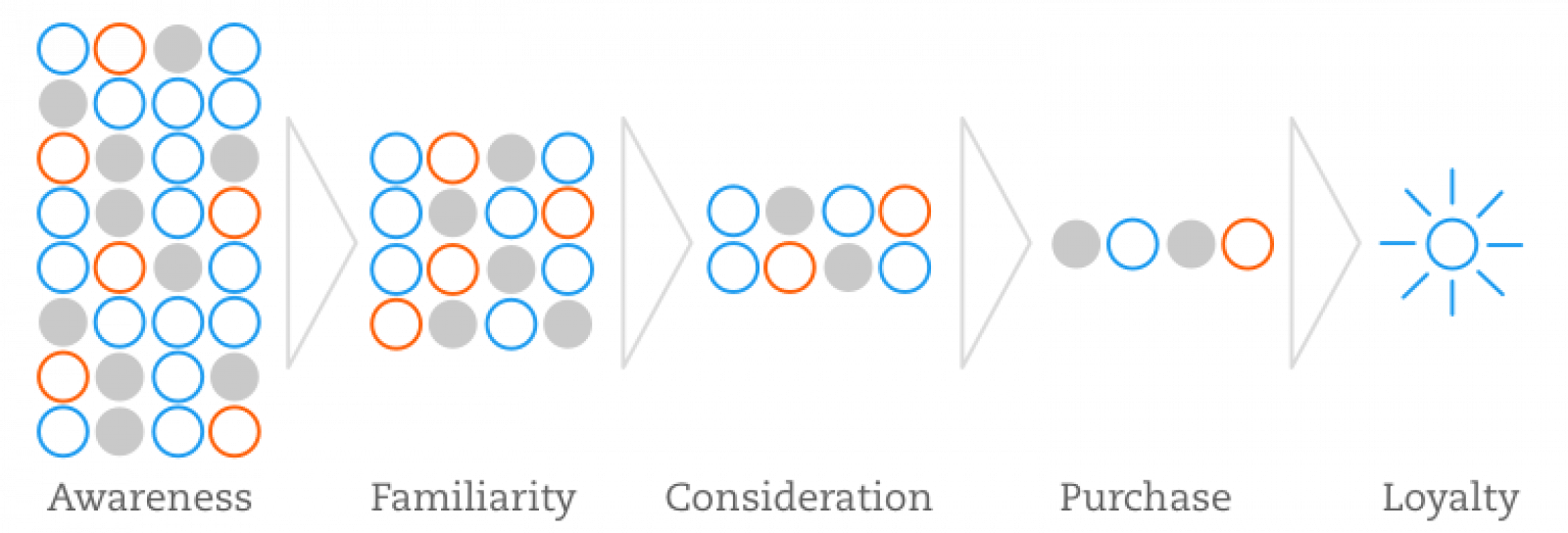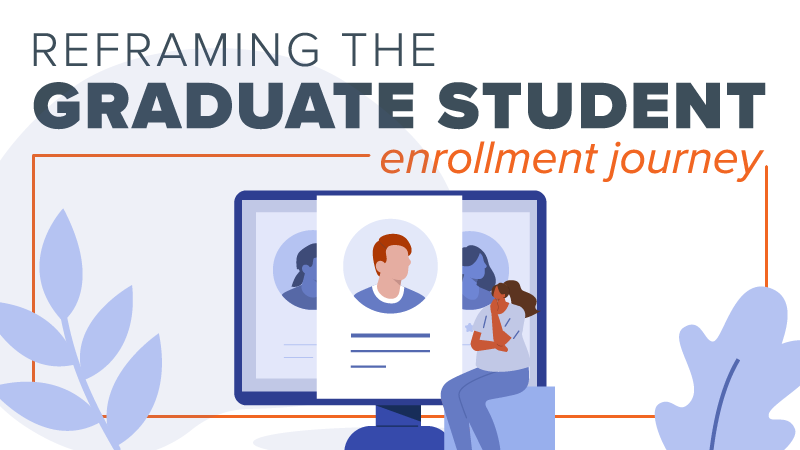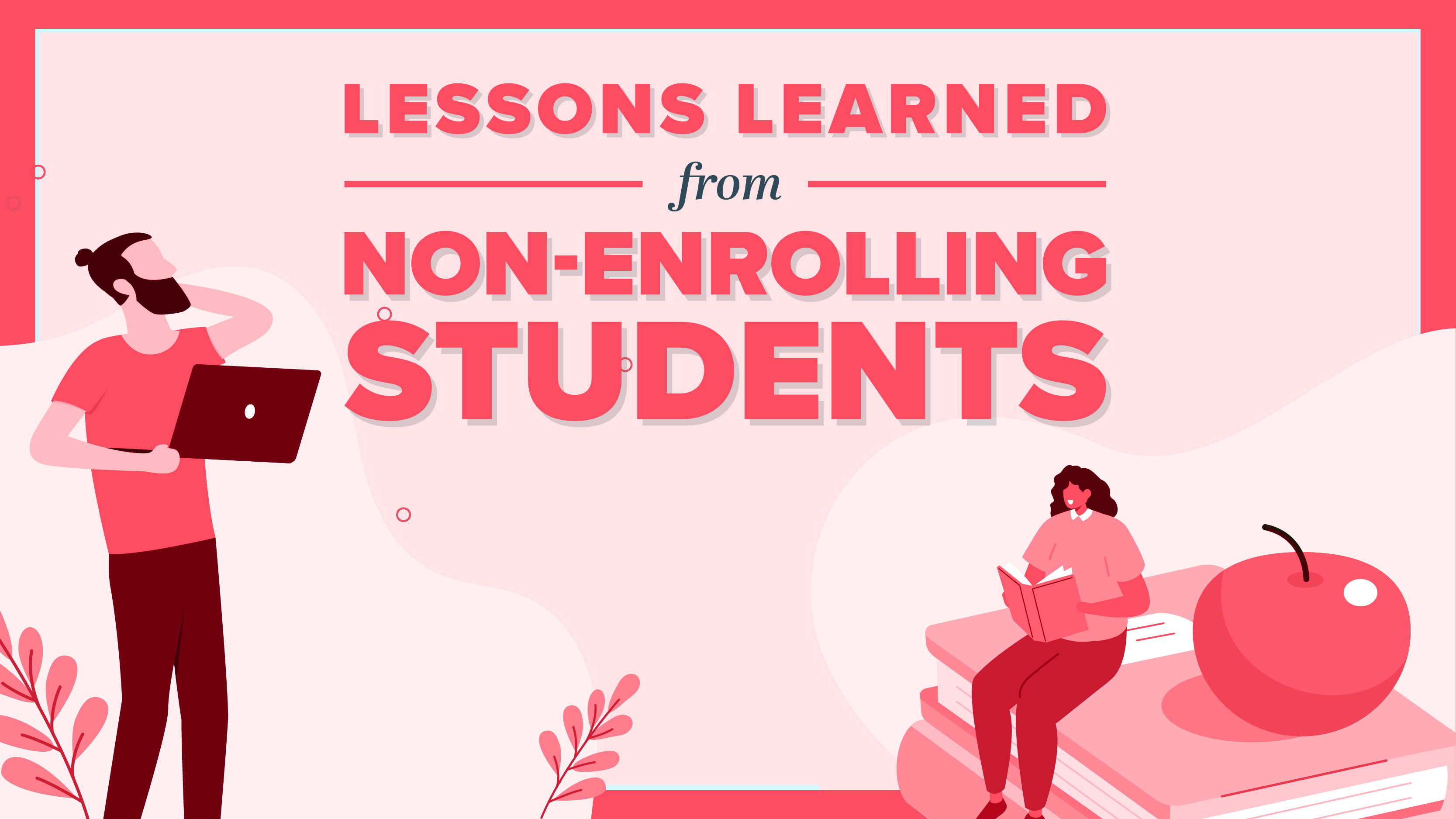Reframing the Graduate Student Enrollment Journey
Prospective students are continually receiving offers from every brand and institution out there, every moment of the day. How do you break through the noise? The first, and most important, step in your enrollment marketing efforts is to truly understand the audience to which you’re speaking (enter: persona modeling — more on that in a minute) and then, to identify how you’ll attract their attention and usher them through the enrollment journey.
In higher education, the enrollment funnel has long been the model used to drive marketing and admissions strategy. However, prospective graduate students don’t adhere to a traditional enrollment cycle, thus, the funnel breaks down. Viewing the graduate enrollment process through the lens of a traditional customer decision journey (more commonly favored by marketers in commercial fields) allows for more flexibility for graduate enrollment managers to maximize efficiency in marketing and recruitment tactics. Let’s explore how to begin making this shift in strategy.

Customize Your Messaging to the Graduate Audience
Like many other efforts in enrollment, your outreach toward the graduate audience must be curated and customized. Because we are working outside of the traditional enrollment funnel, tactics must be hyper-personalized to the student based on not only where they are in their decision journeys, but also in their lives.
Consider this: On one end of the graduate student spectrum, you have the fresh-out-of-undergrad, hungry-to-learn 22-year-old. This student has fewer considerations for finding a graduate program outside of what feels like the right fit. On the other end of the spectrum is the single parent who is looking for a graduate program that will propel them into the next stage of their career; earning them more money and stability for their family. This student’s concerns when looking for a program are limitless — financial aid, flexible scheduling and formats, and time to completion.
The ways in which you speak to these two students should drastically differ, both in means of communication and tone/voice. This is where the adoption of the customer decision journey model, as opposed to the traditional enrollment funnel, is greatly beneficial. This strategy allows us to better understand our prospects and broaden our perspective when it comes to engaging with them.
So, how do we meaningfully customize our engagement toward this audience?
The Power of Personas
Persona modeling is the process of creating representations of who your ideal customers are, informed by research and historical data. This tactic allows for segmenting your audience based on factors such as demographics, psychographics, behavior, and more that you can then apply to your strategic messaging.
The first step of establishing personas is to do some digging: Mine your CRM for data and conduct both qualitative and quantitative research. Once you have your data in place, it’s time to map student information with a solid plan for engagement. Important questions to consider when building this plan include: What are the most important pieces of information this student needs to know? How should we speak to them? What are they motivated and inspired by?
By answering these questions, you should have a clear vision for each of your distinct personas. Now, it’s time to integrate these personas into your graduate student journey map.
Leveraging Personas to Personalize Your Journey Map
Like your prospective students, each persona is unique and will respond differently to messaging throughout their journey. Take each of your customer personas and strategically design their journey map to define targeting, messaging, and communication tactics at each step.
Let’s walk through an example together. Meet Dave, a prospective graduate student of Spark University.

Step 1: Awareness
Dave feels frustrated and stuck in his career. In an effort to climb the corporate ladder, he asks some friends for advice, engages with some professional organizations, networks on LinkedIn, and looks up free professional development opportunities.
How Spark University Meets Him
- Word of mouth
- Free resources (courses, webinars, white papers, podcasts, video)
- Digital media advertising
Step 2: Familiarity
Feeling hopeful about his future, Dave seeks out relevant resources that fit within his specific criteria around the time, energy, and money that he’s willing to spend. Once he has a grasp on these criteria, he researches what different institutions can offer him.
How Spark University Meets Him
- Student/faculty/alumni profiles
- Testimonials
- Events
Step 3: Consideration
Dave has decided that graduate school is the right route for him and his lifestyle. Along with teaching him practical skills and holding him accountable, it will give him the status that comes along with an advanced degree. Dave connects with admissions offices and starts his applications.
How Spark University Meets Him
- Phone calls/text messages
- Live chat
- Meetings (in person or virtual)
- Invitations to attend classes
- Curriculum information
- Student outcome info
- Scholarships/funding
Step 4: Purchase
Dave has chosen Spark University! He has enrolled in classes and is working toward his degree. He is still trying to strike a balance between working and taking classes.
How Spark University Meets Him
- Dedicated advisor
- Text message/email check-ins
- Surveys about experience
- Events
Step 5: Loyalty
Graduate school was a success for Dave. He achieved his goal and is climbing the corporate ladder. He seeks continual professional growth, as well as the honor of supporting his alma mater, in an effort to continue to better himself.
How Spark University Meets Him
- Professional/networking events
- Career resources
- Giveaways
- Donation rewards/recognition
Our modern reality is that everything we do — for every distinct population — must be highly personalized. The prospective graduate population is no exception. These unique students require intentionally tailored messaging that will engage them in meaningful ways. Building personas empowers teams to employ strategic tactics and makes prospects feel important, and marketing to them through the framework of a customer decision journey makes it easier to connect with these students however and whenever they are ready.
The team at Spark451 is ready to discuss your graduate enrollment challenges and help customize your marketing and recruitment strategies using a customer decision journey approach. Feel free to reach out so we can get started.
Lessons Learned from Non-Enrolling Students
Choosing a college — it’s perhaps one of the biggest, most nerve-wracking, high-pressure decisions a student will make. I remember quite well how terrified I was to let my number two and three schools know I wouldn’t be attending. I had built a relationship with their admissions counselors and faculty, received a bunch of fun SWAG after getting admitted, visited several times with overnights, and even started exploring which dorm I might live in at each campus. It felt like a breakup. More than 25 years later, the memory still makes me a bit nauseous.
Hopefully, you survived summer melt. But now, as you reflect on the past recruitment cycle, you are probably asking what you could have done differently for the students you lost along the way.
Spark451 partners with numerous schools to help answer the question, “Why did they not enroll?” through our surveying services. And yes, sometimes the feedback collected is brutally honest and hard to stomach, but the information is beyond valuable, and at times, eye-opening. No matter how hard the feedback may be to hear, these moments of unfiltered honesty can help inform your strategy going forward.
Here, we’ll share five actual student responses from the many we’ve collected on behalf of our campus partners who conducted our Non-Enrolling Student Survey. Each example reflects a common theme that we see across many surveys. We’ll review the insights from each student and offer tips for how you can take action if you ever receive similar feedback from a student.
1: The Call is Coming From Inside the House
“I had a meeting with financial aid and felt that it was very unprofessional. Ultimately, that meeting was the reason I decided against attending the school when it was my first choice.”
Let’s face it. Some conversations, especially surrounding affordability and paying for college, can be tough. Kudos to our financial aid colleagues for helping students and families navigate the reality of college expenses. Looking at the big picture, however, we need to ensure that everyone on campus is consistent in both the messaging and interactions with prospective students who we hope will join our campus community.
Revisit your prospective student and parent outreach and take inventory of the on-campus experience. And I mean ALL OF IT. Especially communications and interactions not coming from the Office of Admissions. Every single touchpoint your institution has can make or break a student’s decision to enroll. Avoid things like impersonal bulk “Dear student” letters, and always consider reinforcing your school’s value proposition within each outreach effort, including such things as career outlook and post-grad outcomes. Consider holding a “Customer Service 101” retreat, and invite everyone from Athletics to the Bursar. Need some guidance? I’d recommend Be Our Guest — Perfecting the Art of Customer Service (A Disney Institute Book) by Theodore B. Kinni.
2: The Good, the Bad, and the Ugly
“I wish there were a better representation of food options, or even a sample cafeteria menu to look over. The food at the Open House was really fancy.”
Are we doing a disservice to prospective students by only sharing the shiny and new aspects of campus? One student commented in their survey response that they were only shown the brand-new residence halls (assigned to upperclassman, unbeknownst to them), and realized somewhat later in the decision process they’d be living in an older, un-air-conditioned dorm their freshman year. They wanted to know the true experience up front, see floor plans, know the amenities, and have a realistic understanding of where they might live not only freshman year, but throughout their college experience. They wanted transparency.
No doubt, there are a plethora of websites and social media platforms where students can go to read reviews about your institution from their peers, current students, parents, and alumni. Make sure you have someone on your team, even a student ambassador, keeping a pulse on what is being shared about your school in these forums. This gives you the opportunity to formulate an appropriate response and put a positive spin on the topic at hand (and, in some cases, correct misinformation!) while you engage with your prospective students.
You should absolutely celebrate and share what is new, special, and top-notch about your institution, no matter how big or small. New construction planned? Fall musical production announced? Biology programs move up in national rankings? Recent alumni donation to support student activities? Shout it from the rooftops. Just be mindful that your prospective students are looking for more than just rainbows and unicorns.
3: Show Me the Money!
“I would have really been happy to be a part of the university for Fall 2023, but unfortunately, even after the institution’s scholarship, I didn’t have enough funds to afford the education.”
According to a Forbes article from July 2023, there was $1.75 trillion in total student loan debt (including federal and private loans) with $28,950 owed per borrower, on average.
What is your institution doing to put the true cost of college expenses into perspective? One survey responder commented that she had wished estimated costs had been shown for the entire span of their four-year college timeframe, not just freshman year — which would’ve offered them a “big picture” idea of what they were signing on for and eliminated some of the future unknown.
Another way to humanize college expenses is by providing various testimonials and stories from current students and families. Every family’s situation is different, of course, but these stories can help show how others have approached paying for such an important investment, whether that’s through additional loans or obtaining an on-campus job. As mentioned earlier, we always want to tie in the value proposition of your institution’s degree and call attention to post-grad outcomes.
For students who have already confirmed their enrollment, getting an initial bill prior to starting classes can also be difficult to process and reason to panic and walk away. Consider sending a pre-bill communication that serves as a soft-touch outreach. Let them know when and what to expect (think “understanding your bill” like you may get from your mobile provider), who to contact with questions, and offer the opportunity to review their bill over the phone or web call, if needed.
4: Great Expectations
“The only reason I chose not to go is campus size. I wanted a bigger-city feel, which my chosen school is able to provide. However, if I end up not liking it there, I will reapply and strongly consider enrolling again.”
We all know that choosing a school often comes down to fit. The student initially chose to apply to your school for a particular reason. Help them recall why they were first interested in your institution to begin with. Sometimes, prompting them back into that earlier mindset can help them reevaluate what is most important to them. Perhaps it was the quality of a particular academic major or an early interaction with a faculty member that had originally sparked their interest.
Your institution may not be in a big enough city for the student above, but what other factors about the student experience could balance that out? Maybe it’s a study abroad opportunity or putting them in touch with a current student who came from a big city and chose your smaller school. Help them look closer at the pros of attending a rural college (i.e. cheaper living options, closer-knit campus community, the offering of student excursions to nearby big cities for a concert, etc.).
Ultimately, we need to respect that the best-fitting school for a student may not be yours. But we can still help them make informed decisions!
5: Groundhog Day
“I decided to not enroll at the college because too many of my friends from high school are going, and I wanted college not to be high school 2.0.”
While some students might find comfort in familiarity at their new home-away-from-home, others might welcome the opportunity for a completely different experience that will be anything but a repeat of high school. Being a teenage introvert, I took it to the extreme in college — joined a fraternity, rowed on the crew team, even got a part in a musical — all things I wouldn’t have dreamed of doing in high school. In essence, college helped me break out of my painfully shy personality. The college experience broke up the monotony and pushed me out of my comfort zone.
What does your institution do to interrupt the “same old, same old” that many prospective students seek to leave behind? It is one thing to showcase your student life and activities, but are we painting the picture of opportunity that will allow the student to see themselves on your campus, while challenging them to grow and experience new things? Having familiar faces around when they begin that journey isn’t necessarily a bad thing. Likewise, staying close to home and attending an in-state school can have its benefits, like special tuition rates. Keep this in mind particularly when working with local students, as well as those coming from your larger feeder high schools. These feelings of wanting to be around a brand-new set of peers are warranted and real, and you should be ready to address them.
What other lessons have you learned from students who chose not to enroll at your institution? I’d love to hear them. The experienced strategy team here at Spark451 would also love the opportunity to help you dive deeper into engaging with your enrolling and non-enrolling students. Please reach out to us to hear about all our student– and parent-surveying options.

